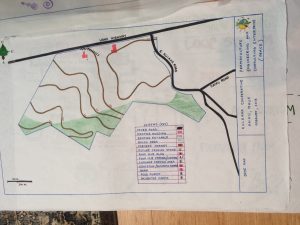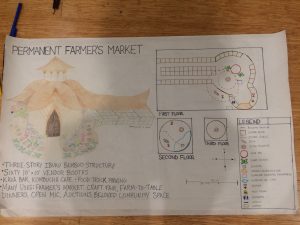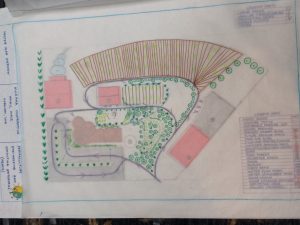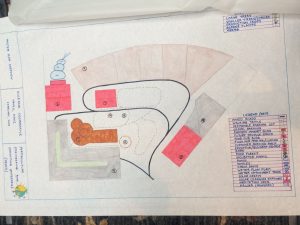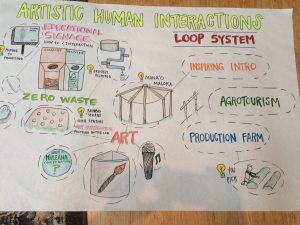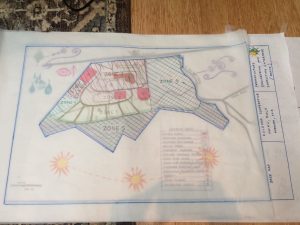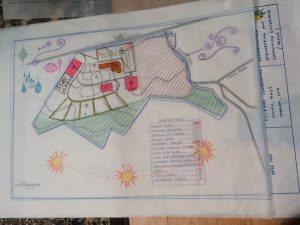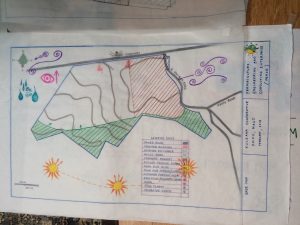This week we were at Evan Ryan’s farm, Pono Grown Farm Center, just upland from Haiku Aina Permaculture Initiative. We delved deeper into the factors we need to consider when designing.
The first idea we discussed was Yeoman’s Scale of Permanence, asking ourselves what the most important things to work with are. These are broken down into climate, geography, water, access, forestry, buildings, fencing, soils, economy, and energy. If we begin by observing and understanding these components, we will establish a solid foundation for further developing the land.
Next we talked about zones and sectors, which are a crucial part of permaculture design and also help us become ecologically connected to our sense of place. Zones are the areas around our living space, and they are relative to each person. They depend on the distance from the center, frequency of use, access needs, and daily schedule.
Zone 00: Your body and own physical space, self care. This includes sleeping, eating, and drinking.
Zone 0: Your home and living space. Includes kitchen, water, bathroom, temperature control, hearth, studio, pets and family.
Zone 1: Places you are visiting multiple times a day. Can include an herb garden, composting toilet, pathways, communal gathering spaces, outdoor shower, fire pit, tool shed. There are also seasonal zone 1s, such as when a certain fruit tree is in season and you are harvesting from it multiple times a day.
Zone 2: Typically areas 25-75 ft from your house (although that can fluctuate). These are areas you are visiting less often, normally once a day. Can include chickens, orchards, food forests, compost, nursery, greenhouse, or in an urban environment cafes, library, school, or temple.
Zone 3: Often areas 75-100 ft from your house. Includes grazing animals, wind break, erosion control, beehives.
Zone 4: Can include food forest, orchard, perennials, gray water or water purification systems, ponds, firewood, agroforestry, hiking trails, meditation yurt.
Zone 5: Wild and undeveloped land.
Sectors are the outside influences on the land. When designing land, we can decide if we want to repel or attract them. They include sun, wind, water, frost, people, noise, smells, fire, energy, microclimates, urban, disaster, view, plants, and wildlife.
Water is one of the most important sectors in permaculture and life. Our bodies are composed of 73.7% of water; without it, we would not survive. Of all the water on the planet, only three percent is freshwater, and only a quarter of this is usable (that is, not locked up in the glaciers). We are depleting our aquifers and lowering our water availability at an alarming rate. We are polluting our rivers and watersheds and chopping down our forests, so our freshwater is getting poisoned and less water is getting transpired into the atmosphere and recycled. Meanwhile the freshwater in the glaciers is melting into the ocean. It becomes essential in permaculture design to maximize the use of water in the landscape. Our motto for water this last week has been “slow it, spread it, sink it,” so water is returned to the aquifers and the soil instead of running off the surface. Ways to store water that we have discussed are: dams and reservoirs, Swales, chinampas, rain catchment, water harvesting off roadways, plants and trees, soil, mulching, sediment traps, water generators, cloud harvesting, aquifers, terracing, and aquaponics. It is key to find the simplest solutions and to have back-ups in order to be resilient.
Evan defined soil as minerals in active biological processes in process. There is an infinite number of best practices to alchemize soil to our needs, but ultimately it comes down to how we can capture free carbon energy to build our soil. Soil can be broken down into nitrogen, phosphorous, potassium, calcium, and trace minerals. Nitrogen supports leaf growth, and can be increased by nitrogen fixing plants, animals, and blood meal. Phosphorous supports flowering and can be built up by animals, bones, and fish bonemeal. Potassium supports vigor and vitality and can be increased by wood ash and green sand. Calcium helps the shell or skin of the plant and can be increased by eggshells, sand, lime, and oyster shells. Trace minerals support the overall health of plants and can be added with seaweed, saltwater, cinders, kelp meal, and rock dust. It is important to keep a balance of all these components, although you can increase specific minerals based on the plants’ needs.
The key to creating good heathy compost is to have the right ratio of carbon to nitrogen, or brown/dry matter to green/wet matter. A good ratio to aim for is about 15-20:1 carbon:nitrogen. It is important to keep the compost aerobic instead of anaerobic so there is enough oxygen to break down the matter and prevent it from smelling too bad. On the other hand, having too much carbon makes the breakdown very slow. The goal is to reach a temperature of 135-140 degrees in order to burn out dangerous bacteria and promote decomposition. The most successful compost piles are a minimum of three feet by three feet by three feet.
The mismanagement of animals is inhumane and leads to factory farming, water pollution, overconsumption, deforestation, and abuse of workers. In permaculture, we can strive to be a part of a cycle that creates a harmonious impact. The benefits of having and caring for animals are: manure, fertility, companionship, food, fiber, fuel, warmth, soil building, pest management, protection, therapy, education, habitat, contributions to the ecosystem, pollination, reclaiming marginal lands, and indicators of change. Caring for animals is about building a relationship in exchange for mutual benefits.
